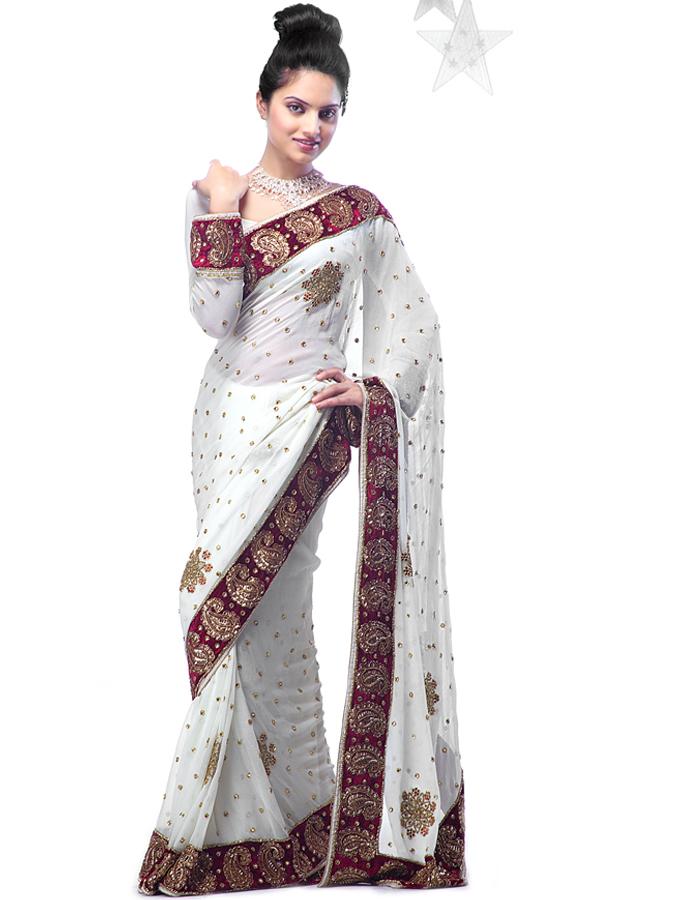Saree Online Usa Biography
Source (google.com.pk)

.jpg)
_large.jpg)






.jpg)
Source (google.com.pk)
Salwar kameez (also spelled shalwar kameez or shalwar qameez) is a traditional dress worn by both women and men in Southern Asia. Salvars or shalvars are loose pajama-like trousers. The legs are wide at the top, and narrow at the bottom. The kameez is a long shirt or tunic. The side seams (known as the chaak) are left open below the waist-line, which gives the wearer greater freedom of movement. It is the most common dress for men in Pakistan and Afghanistan.Clothing in India varies from region to region depending on the ethnicity, geography, climate and cultural traditions of the people of that region. Historically, men and women's clothing has evolved from simple Langotas and loincloths to cover the body to elaborate costumes not only used in daily wear but also on festive occasions as well as rituals and dance performances. In urban areas, western clothing is common and uniformly worn by people of all strata. India also has a great diversity in terms of weaves, fibres, colours and material of clothing. Color codes are followed in clothing based on the religion and ritual concerned. For instance, Hindus lady's wear white clothes to indicate mourning while Parsis and Christians wear white to weddings.India's recorded history of clothing goes back to the 5th millennium CB in the Indus Valley Civilisation where cotton was spun, woven and dyed. Bone needles and wooden spindles have been unearthed in excavations at the site. The cotton industry in ancient India was well developed, and several of the methods survive until today. Herodotus, an ancient Greek historian described Indian cotton as "a wool exceeding in beauty and goodness that of sheep". Indian cotton clothing was well adapted to the dry, hot summers of the subcontinent. Most of the present knowledge of ancient Indian clothing comes from rock sculptures and paintings in cave monuments such as Ellora. These images show dancers and goddesses wearing what appears to be a dhoti wrap, a predecessor to the modern sari.The upper castes dressed themselves in fine muslin and wore gold ornaments The Indus civilisation also knew the process of silk production. Recent analysis of Harappan silk fibres in beads have shown that silk was made by the process of reeling, a process known only to China until the early centuries AD.
According to the Greek historian Arrian:
The Buddha, in Greco-Buddhist style, 1st–2nd century CE, Gandhara(Modern eastern Afghanistan).
"The Indians use linen clothing, as says Nearchus, made from the flax taken from the trees, about which I have already spoken. And this flax is either whiter in colour than any other flax, or the people being black make the flax appear whiter. They have a linen frock reaching down halfway between the knee and the ankle, and a garment which is partly thrown round the shoulders and partly rolled round the head. The Indians who are very well-off wear earrings of ivory; for they do not all wear them. Nearchus says that the Indians dye their beards various colours; some that they may appear white as the whitest, others dark blue; others have them red, others purple, and others green. Those who are of any rank have umbrellas held over them in the summer. They wear shoes of white leather, elaborately worked, and the soles of their shoes are many-coloured and raised high, in order that they may appear taller."
According to the Greek historian Arrian:
The Buddha, in Greco-Buddhist style, 1st–2nd century CE, Gandhara(Modern eastern Afghanistan).
"The Indians use linen clothing, as says Nearchus, made from the flax taken from the trees, about which I have already spoken. And this flax is either whiter in colour than any other flax, or the people being black make the flax appear whiter. They have a linen frock reaching down halfway between the knee and the ankle, and a garment which is partly thrown round the shoulders and partly rolled round the head. The Indians who are very well-off wear earrings of ivory; for they do not all wear them. Nearchus says that the Indians dye their beards various colours; some that they may appear white as the whitest, others dark blue; others have them red, others purple, and others green. Those who are of any rank have umbrellas held over them in the summer. They wear shoes of white leather, elaborately worked, and the soles of their shoes are many-coloured and raised high, in order that they may appear taller."
Saree Online Usa photos Images Pictures 2013

Saree Online Usa photos Images Pictures 2013
.jpg)
Saree Online Usa photos Images Pictures 2013
_large.jpg)
Saree Online Usa photos Images Pictures 2013

Saree Online Usa photos Images Pictures 2013

Saree Online Usa photos Images Pictures 2013

Saree Online Usa photos Images Pictures 2013

Saree Online Usa photos Images Pictures 2013

Saree Online Usa photos Images Pictures 2013

Saree Online Usa photos Images Pictures 2013
.jpg)
Saree Online Usa photos Images Pictures 2013
No comments:
Post a Comment